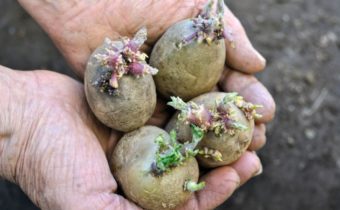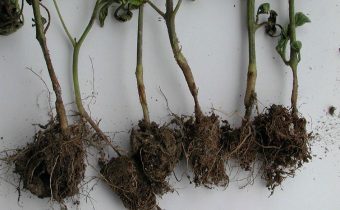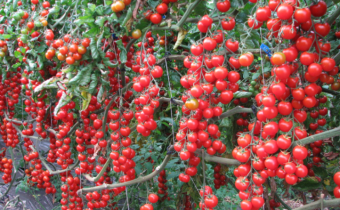The best effective means of fighting the Colorado potato beetle on tomatoes
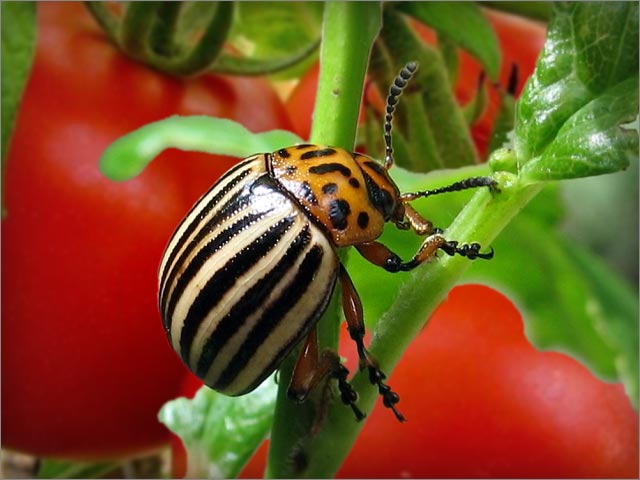
Tomatoes, like other members of the Solanaceae family, most often suffer from invasions of the Colorado beetles. The peak of its activity begins with the onset of stable warm spring weather. Despite the fact that the first mention of the striped pest in the scientific literature dates back to 1842, to this day there is no possibility of 100% protection of the sowing of tomatoes from it. We are talking about the need for comprehensive preventive and therapeutic measures. They are aimed at eliminating risk factors and destroying the Colorado potato beetle, if its occurrence could not be avoided.
Potential harm
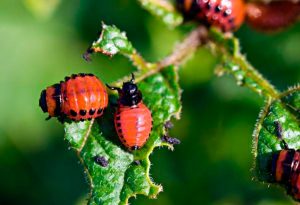 The risk group includes young bushes, on the leaves of which the pest lays eggs. Within a few weeks, multiple larvae appear with characteristic spots on the sides. Since the beginning of their life, the larvae have eaten green leaves in unbelievable quantities. If you do not take prompt response measures, you can lose the entire crop in 20-25 days. As soon as the leaves on one tomato bush are destroyed, young beetles migrate to the next.
The risk group includes young bushes, on the leaves of which the pest lays eggs. Within a few weeks, multiple larvae appear with characteristic spots on the sides. Since the beginning of their life, the larvae have eaten green leaves in unbelievable quantities. If you do not take prompt response measures, you can lose the entire crop in 20-25 days. As soon as the leaves on one tomato bush are destroyed, young beetles migrate to the next.
The onset of consistently warm weather should be alerted. The higher the air temperature, the more larvae will go through the entire life cycle. After eating the leaves, they fall to the ground. Once they pupate, Colorado beetles are ready to lay eggs. Over the next 1.5 weeks, a new generation appears. Adults prefer leaves and directly to tomatoes, the ovary of which actively begins during this period.
Ways to handle seedlings
Existing methods are divided into several categories: chemical, biological and folk. The latter method is effective only with a small amount of invasion. Regardless of the climatic features of the region and the area of planting, it is recommended to use at least 2 means of combating striped pests. In this situation, the Colorado potato beetle does not form immunity.
Existing folk methods
Recipes are based on using environmentally friendly ingredients. A mixture of walnut shells and leaves is widespread due to its effectiveness.
The solution is prepared as follows:
- 1 kg of fresh leaves and 1 kg of walnut fruit;
- 10 liters of boiling water;
- mix everything in a bucket;
- insist with the lid closed for 7 days;
- Before use, drain the solution.
For therapeutic purposes, treatment is carried out every 3 days, and in prophylactic treatment - 1 every 2 weeks.
The second recipe involves the use of white acacia bark:
- 1 kg of dry matter;
- 10 liters of water;
- close the lid and leave for 72 hours in a bucket;
- strain before use;
- handle tomato sowing every 4 days.
In regions with hot climates, tincture based on poplar leaves is used. It is prepared as follows:
- leaves - ½ bucket;
- pour running water;
- boil for a quarter of an hour;
- We supplement the contents with water to a volume of 10 liters
- 3 days to insist with the lid closed;
- strain before use;
- use every 2 days.
When the problem has acquired a chronic form, it will be necessary to adopt more powerful means of fighting the Colorado potato beetle.The list of tincture on the roots of the elecampane opens:
- 100 g of dry matter;
- grind to a powder;
- pour 2 liters of boiling water;
- 2 hours insist with the lid closed.
The first processing of tomato crops is carried out when their height has reached 15 cm. The next 2 treatments are carried out with an interval of 10 days.
Among the popular ways of dealing with the Colorado, dusting technology has proven itself well. For it use the following substances:
- lightly moistened leaves sprinkle 30-50 grams of corn flour;
- 30-50 g of gypsum will provoke guaranteed death of the larvae;
- Birch ash - the most effective way to combat the people's pest.
The latter method is effective in any climate. For the preparation of medicines will need the following components:
- 10 kg of birch ash;
- 1-2 drops of iodine;
- recommended consumption: 9-10 kg for each "weave";
- The treatment is carried out 1 time every 30 days after rain or at dawn.
Completes the list of folk remedies for the destruction of the "striped" beetle tincture based on celandine. It is prepared as follows:
- 1.5 kg of celandine;
- 5 liters of hot water;
- mix everything in a bucket;
- insist about 4 hours;
- filter the resulting mixture;
- pour 2 tablespoons of a 1.5% solution of calcium chloride;
- add water so that the volume of the mixture was exactly 10l.
Processing takes place every 3 days. Recommended consumption - 1 liter for every 1m2.
Chemical control methods
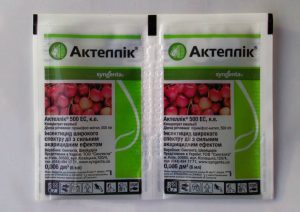 Gardeners use them with increased caution, otherwise the level of concentration of toxic substances in fruits increases many times. The list of effective means to combat the invasion of the beetle includes 5% concentrate emulsion "Aktellik." It belongs to insecticides with a wide range of influence, used no more than 2 times during the period of the second season. For every 10 liters of water is taken 15 g of the substance. The recommended consumption level is 1 l per every 10m2.
Gardeners use them with increased caution, otherwise the level of concentration of toxic substances in fruits increases many times. The list of effective means to combat the invasion of the beetle includes 5% concentrate emulsion "Aktellik." It belongs to insecticides with a wide range of influence, used no more than 2 times during the period of the second season. For every 10 liters of water is taken 15 g of the substance. The recommended consumption level is 1 l per every 10m2.
"Arrivo" - 25% emulsion concentrate is used for the mass raid of the beetle. It is forbidden to use it more than 2 times during a growing season. 1.5 g of the substance is dissolved in 10 l of water. For every 10m2 crops consumed 1 liter.
The list of chemicals listed below continues the list of chemical agents:
- Decis will help to ensure high efficiency with a low level of consumption. Its advantages include resistance to precipitation. The drug does not accumulate in the seedlings. For the preparation of a therapeutic agent, the cottager dilutes 1.5 g of the substance in 10 liters of water. For every 10m2 plot consumes 1 liter.
- Japanese insecticide Sumi-Alpha - used 1-2 times in 1 season. To prepare it takes 1.5 g of the substance and 10 liters of water. For every 10m2 plot consumes 1 liter. The last processing is allowed to be carried out no later than 30 days before the date of harvest.
- Regent is an insecticide of a wide range of effects. Sold in the form of ampoules, the volume of each is 1 ml. To prepare the solution, 1 ampoule is mixed with 10 liters of water. For every 10m2 vegetable garden consumed 1l.
All chemicals to combat Colorado change every year. Otherwise, the striped pest produces a strong immunity to it.
Biological methods of struggle
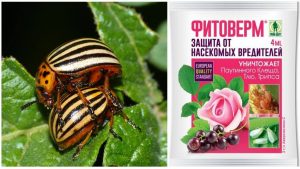 When using them, there is no danger of saturating the tomatoes with chemicals. The list of common biological agents includes the following substances:
When using them, there is no danger of saturating the tomatoes with chemicals. The list of common biological agents includes the following substances:
- "Fitoverm";
- Bitoxibacillin;
- "Bowerin";
- "Agravertin";
- Anthon-F;
- "Colorado";
- "Bicol".
Use any of these funds only at a temperature not lower than + 18C. The second requirement - spraying is carried out on sunny days. The drug enters the body of the pest by contact or intestinal method. 72 hours after processing the sowing of tomatoes, the beetle dies. The only drawback of the biological method of struggle is that it is powerless against the eggs laid by the beetle.
Natural enemies of the Colorado potato beetle
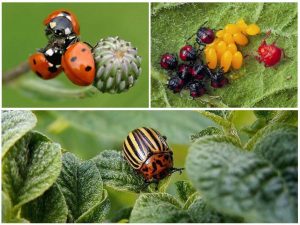 Gardeners who do not want to water their garden with various “chemicals” should adopt a natural biological chain.The list of natural enemies of the striped pest includes the following representatives of the insect kingdom:
Gardeners who do not want to water their garden with various “chemicals” should adopt a natural biological chain.The list of natural enemies of the striped pest includes the following representatives of the insect kingdom:
- spider;
- dragonfly;
- grasshopper;
- garden ground beetle;
- ladybug;
- mantis.
You can lure them to the plot yourself. A grower takes mulch from straw or grass that needs to be laid out under bushes. It forms a comfortable microclimate for insect defenders.
Manual collection of beetles and larvae
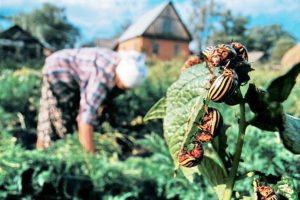 Gardener uses a container in which 50-100 ml of kerosene or diesel fuel are pre-filled. If these substances are not at hand, then adults need to be collected in a deep jar. As soon as the collection process is complete, its contents are burned. In the case when it comes to dealing with larvae, they must be removed along with damaged leaves.
Gardener uses a container in which 50-100 ml of kerosene or diesel fuel are pre-filled. If these substances are not at hand, then adults need to be collected in a deep jar. As soon as the collection process is complete, its contents are burned. In the case when it comes to dealing with larvae, they must be removed along with damaged leaves.
Prevention
Effective control of the Colorado potato beetle begins at the stage of selecting seed. It should not be a trace of rot or disease. Sowing material obtained from recovered tomatoes is not worth taking. A list of other methods to prevent the appearance of Colorads is as follows:
- Regular hilling helps to saturate the soil with oxygen. The result will be the death of the larvae.
- Plant spring garlic around tomatoes. Its scent scares off the pest.
- Conducting regular weeding - the smaller the weed area, the harder it will be for the Colorado potato beetle to settle on the site.
- Next to the tomatoes are planted a representative of the legume family with a bright aroma.
- At the stage of planting seedlings in each well grower puts 10 g of ash. Its smell will temper the appetite of the pest for a long time.
- For preventive purposes, the gardener scatters fresh pine sawdust between bushes. Their smell is guaranteed to scare away the pest. Here the importance of compliance with the schedule. The first wastage is performed before flowering begins - 1 time every 14 days. Since the beginning of flowering sawdust scatter 1 time every month.
- Planting plant defenders between rows of tomatoes. We are talking about sage, catnip, calendula, coriander and tansy.
The latter method has a significant drawback. The grower must constantly cut off the formed flowers, otherwise the seeds will be on the ground. In this situation, the problem of the Colorado potato beetle will fade into the background.
The Colorado potato beetle is a dangerous enemy of solanaceous crops. The starting point in its development will be the constant spring heat. Once the eggs are laid, the next harvest is in danger. Existing options for combating striped pest are divided into biological and chemical. The less effective is the manual collection and popular advice. A grower should not use more than 6 months of fighting against the Colorado potato beetle for more than 6 months, otherwise the insect will have a strong immunity.



